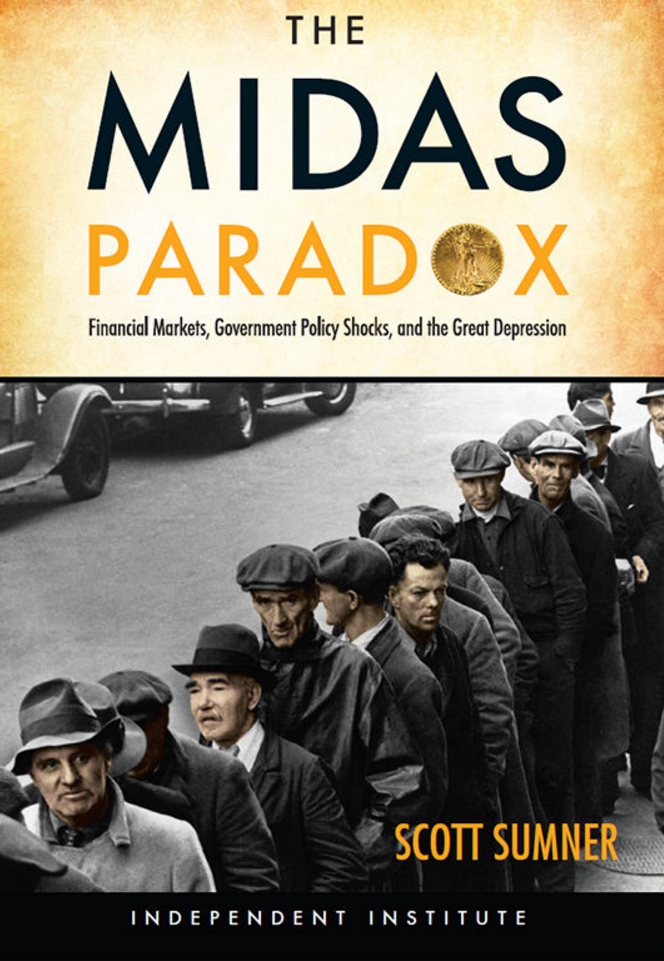
In July 1933, Roosevelt issued an executive order that effectively forced firms to raise nominal hourly wages by 20% in just two months. In the previous 4 months, industrial production had risen by 57%, three times faster than in any other 4-month period in US history. It looked like we would get a rapid recovery from the Depression due to the stimulative effects of dollar devaluation. Unfortunately, the NIRA wage policy aborted the recovery and industrial production began falling. It would not regain July 1933 levels for another 2 years, after the May 1935 Supreme Court decision ruling the NIRA unconstitutional.
Here’s the abstract of a new paper by Jérémie Cohen-Setton (Peterson Institute for International Economics), Joshua K. Hausman (University of Michigan), and Johannes F. Wieland (University of California, San Diego):
The effects of supply-side policies in depressed economies are controversial. We shed light on this debate using evidence from France in the 1930s. In 1936, France departed from the gold standard and implemented mandatory wage increases and hours restrictions. Deflation ended but output stagnated. We present time-series and cross-sectional evidence that these supply-side policies, in particular the 40-hour law, contributed to French stagflation. These results are inconsistent both with the standard one-sector new Keynesian model and with a medium scale, multi-sector model calibrated to match our cross-sectional estimates. We conclude that the new Keynesian model is a poor guide to the effects of supply-side shocks in depressed economies.
In the US, the wage shock was implemented by reducing the work week from 48 hours to 40 hours, without any change in weekly wages. This boosted hourly wages by 20%. The French version was even more extreme, they reduced the work week to 40 hours while increasing weekly wages by 7% to 15%.
In their opening paragraph they point out that this study has important policy implications for Europe:
The output effects of supply-side policies in depressed economies are controversial. Much of the debate has focused on the U.S. New Deal’s supply-side elements, in particular the National Industrial Recovery Act (NIRA).1 Standard new Keynesian models used for policy analysis imply that the NIRA ought to have been expansionary given economic conditions during the Great Depression (Eggertsson, 2012), but many economists have suggested otherwise (Friedman and Schwartz, 1963; Bordo, Erceg, and Evans, 2000; Cole and Ohanian, 2004). More recently, this debate has resurfaced in the context of whether structural reforms would be helpful or harmful for the Eurozone periphery (e.g., Bundick, 2014; Eggertsson, Ferrero, and Raffo, 2014; Fernández-Villaverde, Guerrón-Quintana, and Rubio-Ramírez, 2014; Lo and Rogoff, 2015).
The basic problem with the New Keynesian model is that they use the wrong indicator of nominal (demand) shocks. In the NK model, higher inflation is expansionary. But of course that’s reasoning from a price change. It’s expansionary when caused by an increase in AD (say due to expansionary monetary policy), but contractionary when caused by a decrease in AS (say due to legal mandates forcing wages higher.)
The correct nominal indictor is NGDP growth. An increase in NGDP growth is always consistent with higher AD, and vice versa. If the Keynesians would replace inflation with NGDP growth in their models, they would avoid disastrous policies such as the NIRA, and its French equivalent.
This is just one of the reasons why the market monetarist model is superior to the NK model.
HT: Kurt Schuler
PS. People interested in this subject might want to check out my book on the Great Depression:

READER COMMENTS
Rajat
Mar 13 2017 at 11:08pm
How is it that the really smart people who develop and work with NK models don’t get this? Are they too enamoured of the math?
Rajat Sood
Mar 13 2017 at 11:16pm
…Although, to be fair, my very limited understanding of NK models is that they rely on a particular transmission mechanism – higher inflation causes lower real rates which drives higher spending – and therefore do not self-consciously reason from a price change. So perhaps a flawed view of the transmission mechanism rather than reasoning from a price change per se is why they don’t work well when confronted by supply shocks.
Curmudgeon
Mar 14 2017 at 6:46am
This has been well-known by the better French economists, and for a very long time. Notably by Alfred Sauvy, who, though sympathetic to Léon Blum’s government (for which he worked in 1936), was appalled by their poor understanding of economics.
Michael
Mar 14 2017 at 7:06am
[Comment removed for supplying false email address. Email the webmaster@econlib.org to request restoring this comment and your comment privileges. A valid email address is required to post comments on EconLog and EconTalk.–Econlib Ed.]
Thaomas
Mar 14 2017 at 1:16pm
You are correct that the “Keynesian cross” is not good model for analyzing supply side changes. That not quite the same thing as implying that “Keynesinas” were responsible for NIRA. (Just as they were net responsible for the Fed failing to implement its mandate in 2008-2016.)
Scott Sumner
Mar 14 2017 at 2:05pm
Rajat, Presumably they think the part of their models that accounts for supply shocks takes care of this problem. But I don’t think it does.
Curmudgeon, Yes, I discussed the French case in papers I wrote decades ago. But this is a state of the art empirical piece, much more convincing than anything I did.
Thaomas, Fair point, there was no such thing as “Keynesianism” in 1933, as the General Theory was published in 1936. But there were people making those arguments in 1933, and today we see New Keynesian economists defending the NIRA (such as Gauti Eggertsson.) Paul Krugman has also endorsed the idea of the “paradox of toil”, so it’s certainly a part of modern Keynesianism.
Scott Sumner
Mar 14 2017 at 2:07pm
Thaomas, Larry Summers once wrote a paper defending the NIRA on Keynesian grounds.
Comments are closed.